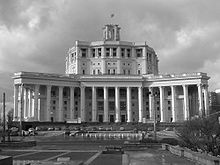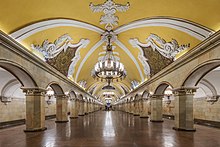Socialist classicism
As Stalinist architecture (derogatory term: cake style ) is architectural style of representative buildings in the Soviet Union in the time of dictator Josef Stalin called (1878-1953). It follows constructivism and puts an end to the Russian avant-garde of the early 20th century in architecture. In addition to the political promotion by Stalin, international trends are also the basis of the change of style; an increasing change to monumental classicist forms in the 1930s can also be observed in the USA and Western Europe.
After the Second World War , this specifically Soviet form of classicism also spread particularly in Poland and the GDR . The style developed partly strong regional peculiarities and developed into a more objective classicism , especially in China and North Korea .
In the early 1960s, the style was replaced by socialist modernism in the Soviet Union, Poland and the GDR . This change took place for art-historical, economic and ideological reasons.
General, characteristics and classification
The Socialist Classicism is a member of Socialist realism , the officially propagated about from the beginning of the 1930s art style was in the Soviet Union. The style is characterized by palatial buildings that contain numerous decorations on the facades , columns , porticoed halls and tower structures. The style, however, is not a pure rulership architecture , but was associated, especially in the early years, with the concept of revolutionizing living conditions and raising the cultural level of the “ working class ” and all “ working people ” (residential palaces, cultural palaces ).
The principle of this architectural form (s) was the qualified quotation of historical building forms in the sense of a "national tradition", so that the elements and forms actually used vary. The term “socialist classicism” is nevertheless suitable for describing the overall phenomenon, since classicist forms were applied across states.
The architectural style went out of fashion with the death of Stalin and de-Stalinization . Since then, the Soviet Union and other socialist states have relied on functionalist and heavily industrialized architecture.
Socialist classicism in different states
Soviet Union

Monumental buildings were erected in many large Soviet cities, especially Moscow . Famous examples in Moscow are the new Stalin building of Lomonosov University , the Ukraina and Leningradskaya Hotels and the Ministry of Foreign Affairs. Together with three other high-rise buildings, these form the so-called " Seven Sisters " group.
The largest building of Socialist Classicism was also to be built in Moscow. It was the Palace of the Soviets (Дворец Советов), which at the time of construction would have been the tallest building in the world at 415 meters. The site of the Cathedral of Christ the Savior, which was demolished in 1931, was to serve as the building site. The Palace of the Soviets was part of a “master plan for urban renewal” which envisaged the conversion of Moscow into a model socialist city. At the same time, there was also a general plan for Leningrad , which included the construction of a new center on Moscow Square (Московская площадь). In terms of its consequences for the historic cityscape , however, the Moscow Master Plan was far more radical.
The Second World War halted construction on the Moscow Palace of the Soviets. After Stalin's death, the project was abandoned and the foundation was converted into an outdoor swimming pool ( Moskva Swimming Pool ). In 1994 the swimming pool was again torn down and a little later the destroyed church was rebuilt.
The Beijing Hotel was built in Moscow in 1946 . The architect was Dmitri Nikolaevich Chechulin (1901–1981), who was also involved in the construction of the White House in Moscow.
Some stations of the Moscow Metro are also typical examples of Socialist Classicism due to the citations of historical architecture and their layout as underground palaces.
In the Latvian SSR , the main building of the Academy of Sciences in Riga was an important building in the style of socialist classicism.
GDR
In Germany there are buildings of socialist classicism in many cities in the area of the former GDR . The political criteria for this were The 16 Principles of Urban Development . Socialist classicism was used both in the reconstruction or rebuilding of destroyed urban areas, for example in Berlin (mainly in Friedrichshain and Mitte ), Magdeburg and Neubrandenburg - as well as in the design and construction of new city districts , such as B. in Rostock-Reutershagen I .

The most important and monumental project was the Stalinallee (today Karl-Marx-Allee ) in Berlin-Friedrichshain. Under the direction of the same architect, Hermann Henselmann (1905–1995), a residential complex was also built in the area of Ostseestrasse . The embassy of the USSR Unter den Linden (today the Russian embassy) is an example of socialist classicism.
Stalinstadt - today's Eisenhüttenstadt - was built from 1950 as a planned city in socialist classicism, as a place of residence for the workers of the newly emerging Eisenhüttenkombinat Ost . Large parts of the city, especially the second residential complex, consist of socialist-classicist buildings. Thus, the ensemble represents an outstanding example of the confectioner's style in the GDR .
In Dresden , the style was used in the reconstruction after the Second World War, mostly based on the Dresden Baroque . Examples of this are the Altmarkt 4-6 / Wilsdruffer Straße 15-21 complex and the Centrum department store on Altmarkt, the buildings along Wilsdruffer Straße ( inner old town ), the buildings on Grunaer Straße ( Pirnaische Vorstadt ) and the buildings of the former university for transport and an entire residential area along Nürnberger Strasse ( Südvorstadt ).
Examples of this building era in Leipzig are the five- to eight-storey houses with the Ring-Café on Roßplatz built by architect Rudolf Rohrer (1900–1968) from 1953 to 1956 on the south-eastern inner city ring . At the same time, based on designs by Heinz Auspurg (1912–2001), the residential buildings on Leipziger Windmühlenstrasse were built as a continuation of the ring development. The early buildings of the central stadium under the direction of Karl Souradny (1904–1973) and the sports forum (especially the bell tower and functional side structures) and some of the former German University of Physical Culture (DHfK) also show clear features of this era.
When the Langen Strasse was rebuilt to become the new main street in Rostock , the architects, e. B. Joachim Näther (1925–2009) a style inspired by the north German brick Gothic.
One of the early buildings of this era is the Chemnitz Palace of Culture , which was built in 1950 as the "Miners' Palace of Culture" by SAG Wismut. Another example in Chemnitz is the prestigious building in the Siegmar district, Jagdschänkenstrasse 50, which was also built from 1951 on behalf of SAG Wismut, the forerunner of SDAG Wismut : after an initial different use, it became the headquarters of the SDAG's headquarters in the 1950s Bismuth. It is a listed building and has been the seat of today's Chemnitz regional office of the Deutsche Rentenversicherung Knappschaft-Bahn-See since 1991 .
More socialist states
In Czechoslovakia , a planned town was built in Ostrov , not far from the small historic town center .
Significant individual buildings of Socialist Classicism are the Palace of Culture in Warsaw , the Hotel “International” in Prague and the Great Hall of the People in Beijing . The House of the People in Bucharest is also often included in Socialist Classicism , although it was only planned and built in the 1980s. This goes back more to the political context than to the historical building.
criticism
The architectural style has been heavily criticized by contemporary architects committed to modernism. They found it monumental and overly ornamented. In popular parlance and in the journalistic press, the style is sometimes pejoratively referred to as “( Stalinist ) confectioner style ”, “Stalin baroque”, “Stalingotik” or “Stalin Empire ”, Russian Сталинский ампир .
Architects of Socialist Classicism
Architects of Socialist Classicism were among others
Soviet Union:
- Ivan Alexandrowitsch Fomin (1872–1936)
- Boris Michailowitsch Iofan (1891–1976)
- Vladimir Georgievich Helreich (1885–1967)
- Nikolai Wassiljewitsch Nikitin (1907–1973)
- Lev Vladimirovich Rudnew (1885–1956)
- Ivan Wladislawowitsch Scholtowski (1867-1959)
- Alexei Viktorovich Shtusev (1873-1949)
- Vladimir Alexeyevich Shchuko (1878–1939)
- Noi Abramowitsch Trozki (1895–1940)
- Dmitri Nikolaevich Chechulin (1901–1981)
GDR:
- Heinz Auspurg (1912-2001)
- Edmund Collein (1906-1992)
- Hermann Henselmann (1905–1995)
- Kurt Liebknecht (1905–1994)
- Johannes Rascher (1904–2006) - some buildings
- Rudolf Rohrer (1900–1968)
- Herbert Schneider (1903–1970) - some buildings
- Karl Souradny (1904–1973)
literature
- Bruno Flierl : Built GDR - About urban planners, architects and power. Verlag für Bauwesen Berlin, Berlin 1998, ISBN 3-345-00655-3 .
- Dmitrij Khmelnitsky: The architecture of Stalin. Studies in ideology and style. ibidem-Verlag, Stuttgart 2007, ISBN 978-3-89821-515-2 .
- Birk Engmann: Building for Eternity: Monumental architecture of the twentieth century and urban planning in Leipzig in the fifties. Sax-Verlag, Beucha 2006, ISBN 3-934544-81-9 .
- Alexej Tarchanow, Sergej Kawtaradze: Stalinist architecture. Klinkhardt and Biermann, Munich 1992, ISBN 3-7814-0312-2 .
- Stalinist architecture under monument protection? (= ICOMOS - Hefte des Deutschen Nationalkomitees , XX), Munich 1996, ISBN 3-87490-667-1 ( online , PDF)
Individual evidence
- ↑ Julian Blunk: Risen from the ruins. The construction of cultural traditions of a traditional society in the reconstruction of the Soviet Zone. In: Matthew Philpotts, Sabine Rolle: Contested Legacies. Constructions of Cultural Heritage in the GDR. Camden House, Rochester / New York 2009, pp. 7–29, on p. 25.
Web links
- Bryla.pl Socialist architecture in Poland: masterpieces of architecture from PRL
- Georgi Bogdanov, Boris Missirkov: Palaces for the people. Retrieved April 19, 2019 .




